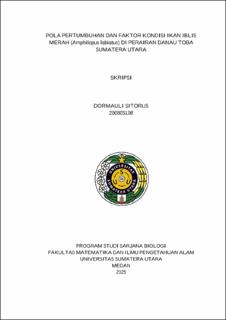| dc.description.abstract | The red devil fish (Amphilophus labiatus) is a type of predatory fish that also invasive. It is posing a threat to the endemic fish and other economically important fish species in a body of water. The presence of the red devil fish in Lake Toba has been caused a decline of the fish diversity, shifting in fish population structure, and an elongating the food chain, also potentially disrupting the existence of other fish species in the lake. This study aims to analyse the relationship between the density of the red devil fish and the physicochemical factors of Lake Toba, to examine the growth patterns of the fish, and to evaluate the condition factor of the red devil fish in Lake Toba. The study began by determining sampling locations using purposive sampling based on the activities around the lake: station 1 in Ajibata water, station 2 in Ajibata water, and station 3 in Ambarita water. Sampling was conducted using net method, then the fish samples were measured for their length and weight. The physicochemical factors of the water were also assessed. Data are analysed including the growth patterns, the condition factors, the population density, and the correlation analysis. The growth pattern of the red devil fish in Lake Toba is found to be negatively allometric, meaning the body length growth is more dominant than weight gain. The condition factor values of the red devil fish range from 1.140 to 1.726, indicating that the fish body is less flattened. Based on the correlation test conducted, the physicochemical factors of the water show the oxygen saturation and the phosphate levels are strongly correlated to the density of red devil fish. | en_US |


